Volker Stelzmann | |
|---|---|
 Stelzmann at Art Cologne in 1985 | |
| Born | 5 November 1940 |
| Occupation(s) | Painter, graphic artist |
| Spouse | Henriette Arndt |
Volker Stelzmann (born 5 November 1940) is a German painter and graphic artist. [1]
Volker Stelzmann | |
|---|---|
 Stelzmann at Art Cologne in 1985 | |
| Born | 5 November 1940 |
| Occupation(s) | Painter, graphic artist |
| Spouse | Henriette Arndt |
Volker Stelzmann (born 5 November 1940) is a German painter and graphic artist. [1]
Born in Dresden, Volker Stezmann was the third recorded child of a railway official Kurt Stelzmann and his wife Charlotte. He was born some eighteen months after a resumption of general European war had been triggered when Europe's two leading dictatorships had launched a military rerun of the Partitions of Poland. Stelzmann's father was killed in the fighting in 1944. Early in 1945 much of Dresden was destroyed by two nights of intensive bombing. Volker Stelzmann survived, but in 1948 the remaining family members relocated to Leipzig which is where Volker Stelzmann grew up and where for more than two decades he would build his artistic and academic career. [1] [2] After leaving middle school, between 1957 and 1960 he undertook an apprenticeship in precision mechanics, continuing with this type of work till 1963. [1] Simultaneously he was attending evening classes at the Hochschule für Grafik und Buchkunst Leipzig, where he was at this stage taught by Walter Münze (1895-1978).
In 1963 he became a full-time student at the Hochschule where he studied with Gerhard Kurt Müller. He was taught the more basic elements of art and graphic art by Fritz Fröhlich, Hans Mayer-Foreyt and Harry Blume. All this led to his degree in 1968. While he was studying he also had the opportunity to come to terms with the essays of Michel de Montaigne. Two years before he graduated, in 1966 he had his first exhibition, jointly with Ulrich Hatulla. This exhibition took place in Ahrenshoop. Subsequently, his work was included in important exhibitions both within the German Democratic Republic and abroad. [1]
From 1968 he pursued a career as a free-lance artist. He had undertaken the first of several study trips to the Soviet Union in 1966, and during the next few years he was also able to visit Bulgaria, Cuba and India. Between 1970 and 1986 he was a member of the National League of Visual Artists, serving as chairman of the organisation's national executive from 1978. He returned to the HfGuB for post-graduate study in 1973, and was teaching there from 1975. He was given a lectureship and appointed a department head at this institution in 1979. In 1982 he became a full professor, and he continued to teach at the HfGuB till 1986. [1]
By the time Stelzmann was grown up the slaughter of war and subsequent large-scale emigration from East Germany had left the country increasingly short of working-age population and after 1961 the government created an increasingly sophisticated set of systems and controls to prevent its remaining citizens from escaping. Travel privileges based on his artistic status nevertheless gave Stolzmann the opportunity to "escape" in 1986 when he returned from an exhibition in Oberhausen (in West Germany) not to the German Democratic Republic but to the enclave of West Berlin which was outside the control of the East German government. Remaining in the west, between 1987 and 1988 he held a guest professorship at the Städelschule (fine arts academy) in Frankfurt am Main. In 1988 he was appointed Professor for Painting at the Berlin Fine Arts Academy (as it was then called). [1] This prompted a protest from the painter Georg Baselitz who now resigned his own teaching position at the university, condemning Stelzmann as a "party-line East German artist". [3] [4] (Baselitz, like Stelzmann, had begun his artistic career in the German Democratic Republic, although he had made his own "escape to the west", after falling foul of the country's political rulers, back in 1958.) Stelzmann retained his professorship at the Berlin University of the Arts (as the Fine Arts Academy had by now become) till 2006. [2]
"Already in the 1970s Stelzmann is painting - sometimes dramatically, sometimes covertly - scenes of a youth as wild in the east of the divided Germany as in its western part. He shows social conflict, and distortions, deep loneliness, conflicts, and violent outbreaks. Unusually in East Germany, he observed the political turmoil of those times in the west, and in particular shared in the turbulence of the "'68 generation". He followed and painted the Baader-Meinhof drama, up to the culminating collective suicide in Stammheim, he mourned Rudi Dutschke with an epitaph, and produced a series of pictures of open and secret anarchists, the demonstrators and "Amokläufern" (Ammunition throwers), as one of the pictures was entitled. His painted observations included bludgeoning police, rockers and punks, and quietly blended in self-portraits, along with portraits of his friends. In retrospect his depictions seem prophetic. They anticipate the street protests and uprisings of 1989. But they also reflect a premonition of social neglect and of the aimless and aggressive young people who make the streets unsafe, above all in the unemployment black spots of former East Germany. At the time, however, East German gallery-goers would have seen such images only as representing disenfranchisement of angry youth in the evil decadent west, while any underlying youth problems in the German Democratic Republic remained out of sight. Stelzmann himself never concerned himself in sociological interactions, causes and outcomes. He was moved by the many diverse manifestations of the people themselves - protagonists and victims and the many "extras". In this way he made his own a maxim more usually associated with Otto Dix, that the artist themselves do not teach and instruct, but should bear radical witness, not in order to understand and present the "sin", where they were not themselves its perpetrator. [5]
Stelzmann schildert schon in den siebziger Jahren – manchmal drastisch, manchmal verdeckter – Szenen einer wilden Jugend im Osten wie im Westen, er zeigt soziale Konflikte und Deformationen, abgründige Einsamkeiten, Konflikte, Ausbrüche der Gewalt. Der Maler hatte als Beobachter im Osten wie kein zweiter an den politischen Umbrüchen im Westen, besonders an den Turbulenzen der 68er-Generation teilgenommen. Er verfolgte und malte das Baader-Meinhof-Drama bis zum kollektiven Selbstmord in Stammheim, betrauerte in einem Epitaph Dutschke, widmete Serien von Bildern den latenten wie den offenen Anarchisten, den Demonstranten und „Amokläufern" (so ein Bildtitel), der Apo samt knüppelnder Polizei, den Rockern und Punkern und mischte sich mit seinem Selbstbildnis und den Porträts seiner Freunde unter sie. Diese Bilder muten im Rückblick wie Prophetie an. Sie nahmen die Straßen-Demonstrationen und das revolutionäre Aufbegehren von 1989 vorweg. Sie geben aber auch eine Vorahnung von einer sozial verwahrlosenden, ziellosen und aggressiven Jugend, die heute die Straßen vor allem im arbeitslosen Osten unsicher machen. Damals dachten die DDR-Aufseher, ihr Maler habe nur den bösen, dekadenten Westen im Visier und übersahen, dass vor allem sie selber und die verdrängten und unterdrückten Jugendprobleme im eigenen Land gemeint waren. Stelzmann interessierten nie gesellschaftliche Zusammenhänge, nicht Ursache und Wirkung. Ihn bewegt auf vielfach exaltierte Weise der Mensch selber – der Täter und das Opfer und die vielen Statisten. Dabei machte er sich die Maxime von Dix zu eigen, dass Künstler nicht bessern und belehren, sondern radikal bezeugen sollen, ja dass sie die „Sünde" nicht verstehen und darstellen können, wenn sie diese nicht selbst begangen haben. [5]
Volker Stelzmann continues to work in Berlin-Charlottenburg where he lives [2] with his wife Henriette whom he married in 1988. His works continue to feature in exhibitions, and despite his defection back in 1986, his work has continued to be celebrated in Leipzig. [6]
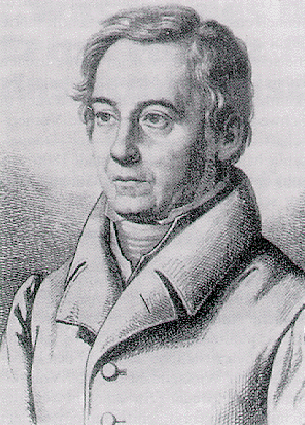
Ernst Moritz Arndt was a German nationalist historian, writer and poet. Early in his life, he fought for the abolition of serfdom, later against Napoleonic dominance over Germany. Arndt had to flee to Sweden for some time due to his anti-French positions. He is one of the main founders of German nationalism during the Napoleonic wars and the 19th century movement for German unification. After the Carlsbad Decrees, the forces of the restoration counted him as a demagogue.

Regine Hildebrandt was a German biologist and politician.

The old states of Germany is a jargon referring to the ten of the sixteen states of the Federal Republic of Germany (FRG) that were part of West Germany and that unified with the eastern German Democratic Republic's 5 states, which are given the contrasting term new states of Germany. Usage of this terminology usually excludes one other state, Berlin, conterminous with the capital city of the reunified nation which used to be divided, with its western part linked with West Germany.
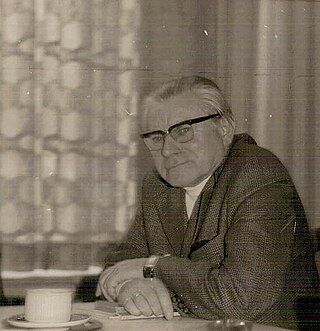
Eberhard Achterberg was a religious scholar, a journalist, a high-ranking Nazi official in the Amt Rosenberg and later a leading member of the German Unitarian Religious Community and school and university teacher.
The Kaisermarsch is a patriotic march composed by Richard Wagner in 1871 in order to exalt the foundation of the German Empire after the victorious Franco-Prussian War.

Herbert Köfer was a German actor, voice artist, and television presenter. He was the first German TV news presenter for the East German Deutscher Fernsehfunk, and also presented the station's last news before the reunification of Germany. His first theatre engagement was in 1940, and he kept acting until the age of 100. Köfer played an SS-Hauptsturmführer in the 1963 film Nackt unter Wölfen. He was known for detective series such as Polizeiruf 110 and for comic roles. He founded his own troupe, Köfers Komödiantenbühne, in 2003, and published memoirs.
Harich Group was the originally derogatory name given by the East German justice and media establishments to the defendants in a high-profile 1957 criminal trial against a "circle of like minded persons".
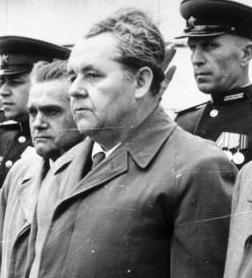
Paul Merker was an activist member of Germany's Communist Party who later became a politician and a top official of East Germany's ruling SED .

Helmut Müller-Enbergs is a German political scientist who has written extensively on the Stasi and related aspects of the German Democratic Republic's history.
Michael Weidt is a German photographer. He is known, in particular, for his portraits of East German theatre and movie stars. His repertoire has also covered the worlds of music, dance and the visual arts more generally.
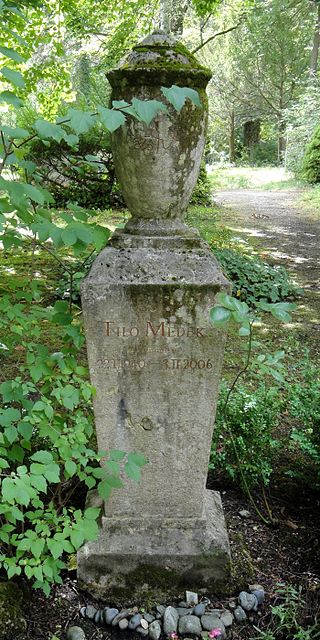
Tilo Medek, originally Müller-Medek, was a German classical composer, musicologist and music publisher. He grew up in East Germany, but was inspired by the Darmstädter Ferienkurse. He composed radio plays and incidental music. His setting of Lenin's Decree on Peace led to restrictions, and after he showed solidarity with the expatriated Wolf Biermann, he also had to move to the West, where he composed an opera Katharina Blum based on Heinrich Böll's novel, and worked in education. He received international awards from 1967 onwards.
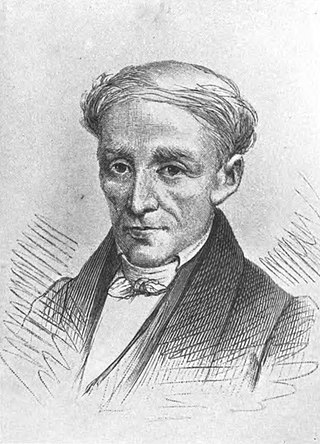
"Weißt du, wie viel Sternlein stehen" is a German lullaby and popular evening song. The lyrics were written by the Protestant pastor and poet Wilhelm Hey (1789–1854), who published them first in 1837. The melody is recorded back to 1818. A poetic English translation of the first and third verse is by Henry William Dulcken (1832–1894).

Christa Luft is a German economist and politician of the SED/PDS. Luft joined the SED in 1958. From 18 November 1989 to 18 March 1990, she was the Minister of Economics in the Modrow government. From 1994 to 2002 she was member of the Bundestag for the PDS.

"Das Grab ist leer, der Held erwacht" is a Catholic hymn for Easter, first printed in 1777 in the hymnal Landshuter Gesangbuch published by Franz Seraph von Kohlbrenner. Keeping only the first of five stanzas, with additional two stanzas, it appeared in hymnals of the 19th century, and later in different versions in several regional sections of the Catholic hymnal Gotteslob. It is a frequently sung hymn in Easter services.
A war of annihilation or war of extermination is a type of war in which the goal is the complete annihilation of a state, a people or an ethnic minority through genocide or through the destruction of their livelihood. The goal can be outward-directed or inward, against elements of one's own population. The goal is not like other types of warfare, the recognition of limited political goals, such as recognition of a legal status, control of disputed territory, or the total military defeat of an enemy state.
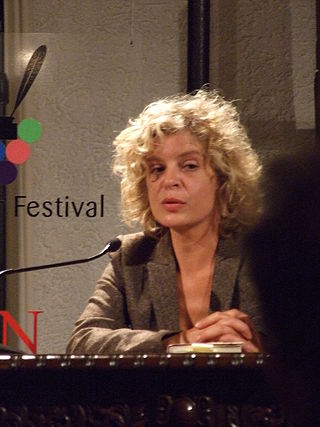
Susanne Schädlich is a German writer and literary translator. She is also experienced as a "ghost writer".
Sigrid Damm-Rüger was a German feminist activist who initially came to prominence in September 1968 through a tomato throwing incident at the 23rd congress of the German Socialist Students' Union, and subsequently became an author specialising in professional education and training.
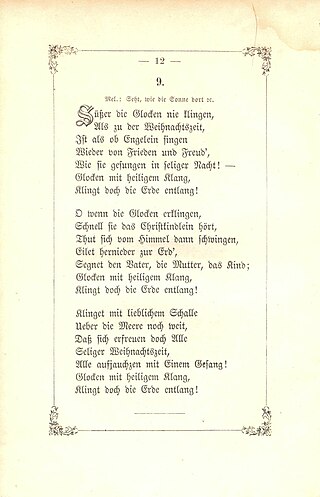
"Süßer die Glocken nie klingen" is a popular German Christmas carol with text by Friedrich Wilhelm Kritzinger to a traditional Volkslied melody, first printed in 1860. It has remained popular and is part of many song books and Christmas recordings, evoking the sound of bells as a symbol of peace and joy.

Uschi Brüning is a German jazz and soul singer and songwriter. She made her career in East Germany and was 42 when the Berlin wall was breached. She has transitioned and sustained her career more successfully than other former East German performance artists post-reunification, though her fan base remains concentrated principally in the east.

Uta Bresan is a German schlager / folk singer and television presenter. Commentators pay tribute to her enduring versatility in both capacities.